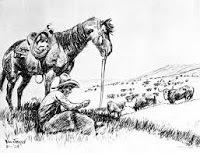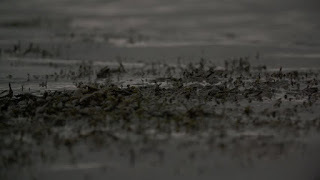Mud
 Will JamesThe romantic picture of the lean, seasoned, tough, sun-browned cowboy riding his pony across the endless, wind-swept prairies, hand-rolled cigarette clamped between firm lips and keen eyes narrowed against the glint of the sun, is just that. A picture.According to my Uncle Owen, the reality was far, far different.Also . . .The great cattle-liners of today didn’t exist in the 1920s. No convenient 18-wheeler showed up at the home corral to load and transport your cattle to wherever you needed them to go.Instead, cattle were herded from their native pastures (sometimes a trip of many, many days) to the nearest railhead and put into cars there.When arrangements went according to plan.And there were cars available . . .Over to Uncle Owen:The fall of 1924 was extremely wet.Crops were not harvested until late in the year and the sugar beets were very difficult to get out of the ground.We cut our beef (selected the animals that were ready for slaughter) along in October, intending to drive them to Magrath (Alberta) to ship out to Winnipeg. But when we got them all ready to leave, we found that we couldn’t get stock cars to ship them in.So we had to herd them for a week or ten days. (With no corrals, someone had to be in the saddle 24 hours a day to keep the cattle together.)It was during this period that I got my first experience at night herding in bad weather. We had about 300 head of beef cut out and I took a shift herding these cattle during each night for about five or six hours.Pure misery.It was snowing and raining most of the time but not cold enough for the snow to accumulate on the ground. It melted just about as fast as it fell and the ground was a swamp any place you wanted to put your foot.When we finally did get cars and were able to take the cattle into Magrath, we had to ride our horses all the time we were handling them in the stockyards because the water and mud was so deep [there] that a man couldn’t wade around in it.
Will JamesThe romantic picture of the lean, seasoned, tough, sun-browned cowboy riding his pony across the endless, wind-swept prairies, hand-rolled cigarette clamped between firm lips and keen eyes narrowed against the glint of the sun, is just that. A picture.According to my Uncle Owen, the reality was far, far different.Also . . .The great cattle-liners of today didn’t exist in the 1920s. No convenient 18-wheeler showed up at the home corral to load and transport your cattle to wherever you needed them to go.Instead, cattle were herded from their native pastures (sometimes a trip of many, many days) to the nearest railhead and put into cars there.When arrangements went according to plan.And there were cars available . . .Over to Uncle Owen:The fall of 1924 was extremely wet.Crops were not harvested until late in the year and the sugar beets were very difficult to get out of the ground.We cut our beef (selected the animals that were ready for slaughter) along in October, intending to drive them to Magrath (Alberta) to ship out to Winnipeg. But when we got them all ready to leave, we found that we couldn’t get stock cars to ship them in.So we had to herd them for a week or ten days. (With no corrals, someone had to be in the saddle 24 hours a day to keep the cattle together.)It was during this period that I got my first experience at night herding in bad weather. We had about 300 head of beef cut out and I took a shift herding these cattle during each night for about five or six hours.Pure misery.It was snowing and raining most of the time but not cold enough for the snow to accumulate on the ground. It melted just about as fast as it fell and the ground was a swamp any place you wanted to put your foot.When we finally did get cars and were able to take the cattle into Magrath, we had to ride our horses all the time we were handling them in the stockyards because the water and mud was so deep [there] that a man couldn’t wade around in it.
 I don’t know about you, but the picture of someone hunched and freezing against the onslaught of rain and snow and with his horse knee-deep in mud and water rather spoils my image of the ‘cowboy’.Maybe it’s for the best . . .
I don’t know about you, but the picture of someone hunched and freezing against the onslaught of rain and snow and with his horse knee-deep in mud and water rather spoils my image of the ‘cowboy’.Maybe it’s for the best . . .
Published on October 26, 2017 08:52
No comments have been added yet.
On the Border
Stories from the Stringam Family ranches from the 1800's through to today.
Stories from the Stringam Family ranches from the 1800's through to today.
...more
- Diane Stringam Tolley's profile
- 43 followers



